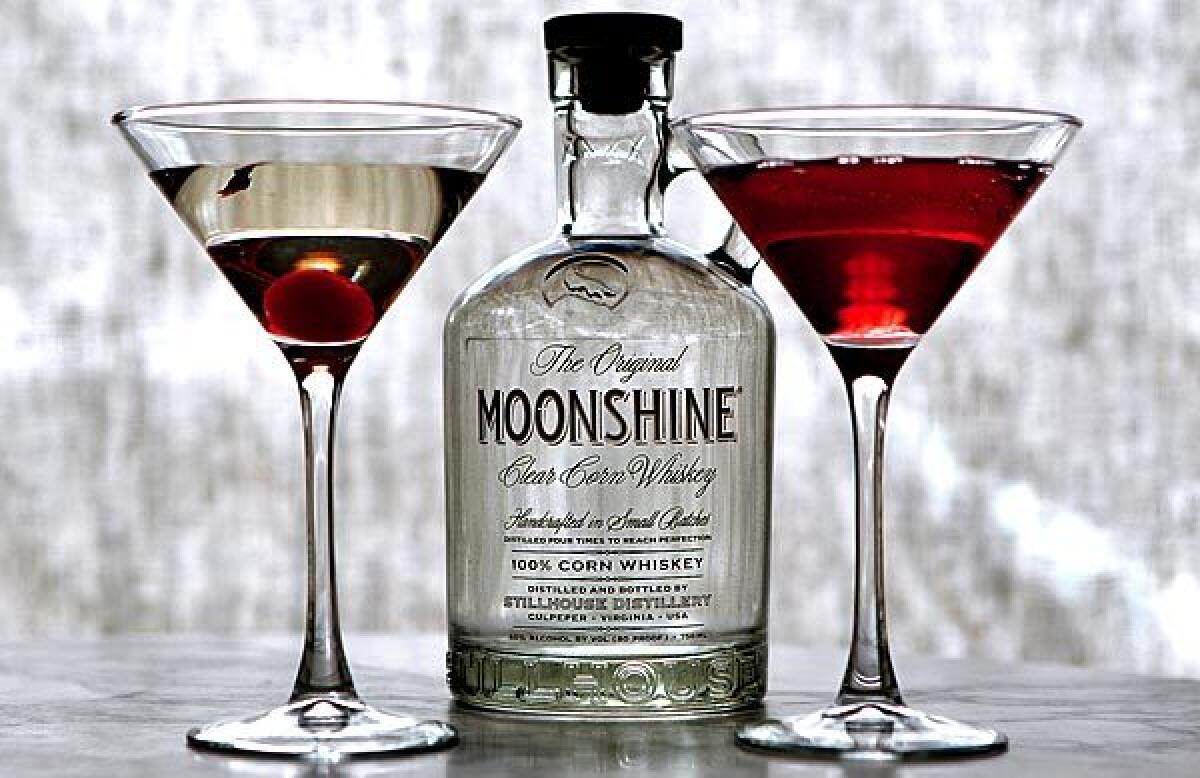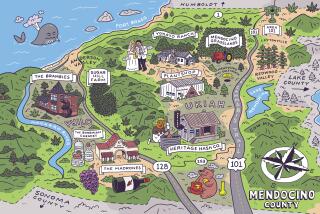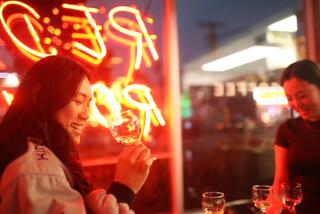Moonshine’s profile rises in Los Angeles bars

Moonshine is having its day in the sun.
Once a back-road country cousin, it is taking on a new life as a city slicker. And now that it’s out of the barn and into the bar, mixologists at tony drinking dens are experimenting with moonshine, and spirit enthusiasts — always on the prowl for the newest kick — are responding with alacrity.
Think of it as whiskey light. Made from grains such as corn, wheat, rye or barley, moonshine never rests inside a wooden barrel, which is why it remains clear, rough and ready. Wood is what gives straight bourbon its rich dark color and most of its caramel-vanilla flavor.
That’s why moonshine is special, say craft distillers. Unkissed by wood, moonshine retains the purity of its nature and drinkers get the chance to experience whiskey in its raw form — to taste its rough-hewn, chewy-grain edges.
Plus, it’s pretty. “L.A. is very look-driven and people are extremely conscious of what they’re drinking — what they’re holding in their hand,” says Shannon Beattie, the beverage director at Cecconi’s, a ritzy Italian restaurant in West Hollywood that serves a wide variety of moonshine cocktails alongside its menu of goat cheese and summer truffle pizza and Dungeness crab ravioli. “And this really sells because it gets people talking. It looks unique — how the light shines through the glass, and you can see the cherry in a white Manhattan.”
Others appreciate it because it’s a bit of the frontier in a bottle and to drink it is to drink in the history of American whiskey.
“During the Colonial period, aging was circumstantial, it wasn’t purposeful,” says Frank Coleman, senior vice president of the Distilled Spirits Council of the United States. “If you happened to leave a spirit in a barrel, aging occurred.” When settlers shipped goods up the Mississippi River to the Ohio Valley, barrels were valuable commodities, so if a barrel held a ripe item like salted cod, the inside of the barrel would be scorched to get rid of the fish flavor. If whiskey, which was clear at the time, was put in such a barrel and left there long enough, it aged and picked up both dark color and caramel flavor. Eventually it became required by law that bourbon had to age in wood for a certain period of time.
Traditionally, moonshine was called moonshine because it was illegal — made under shadowy circumstances by the light of the moon, and thus untaxed. This new legal breed of clear whiskey, also called “white dog” (the one that’s being eaten with truffle pizza inside genteel restaurants) is more like sunshine. And if outlaw Appalachian moonshine met dapper sunshine in a dark alley, there is no question about which one would be down for the count. The country cousin is much harsher than the city slicker.
Still, the final product that many of today’s licensed distilleries are producing is made using much the same process that the bootleggers of the Prohibition era employed. For example, the Original Moonshine — a clear corn whiskey made by Stillhouse distillery in Culpeper, Va. — owes its earthy, corn-laden bite to the skills of a third-generation distiller named Chuck Miller, who uses a similar recipe and vintage copper pot stills that his grandfather used to make illicit moonshine in the 1930s.
“He had 11 kids, and the only job he ever had was making whiskey,” says Miller, adding that there was a trapdoor in the floor of the family farmhouse that led to a basement filled with moonshine. His grandmother kept her rocking chair over it. “Whenever they came to raid she would run to that rocking chair and crochet.”
Stillhouse is one of the spirit’s most visible distillers. It has bottles in more than 70 bars and restaurants around L.A., including Cecconi’s, Hungry Cat, Roger Room, Hemingway’s and Copa d’Oro. And in a particularly sunshiny marketing move, the brand was launched by chief executive and co-founder Brad Beckerman during New York Fashion Week at the 10th anniversary party of designer John Varvatos. No, this isn’t the moonshine the dueling banjo players were drinking in the backwoods of the film “Deliverance.”
With its freshly minted designer reputation, this new wave of clear whiskey owes its popularity to the proliferation of small, craft distilleries in recent years. In February 2010 the Distilled Spirits Council created a craft distiller affiliate membership, in recognition of the growing number nationwide. They estimate there are more than 200 distilleries now in operation, up from about 24 in 2001.
“Spirits have been on the rise over the last decade,” explains the council’s Coleman. “More people are drinking spirits — and better spirits.” And thanks in part to the recession, many states have loosened their restrictions on licensing in order to gain revenue quickly. More distilleries mean more tax dollars straight into state coffers.
In addition, the distillers themselves — often small business people with hefty loans — also need to make money quickly, which is why they tend to put out a clear whiskey right off the bat. Whereas traditional American whiskeys can take four to eight years to be fully mature, moonshine can be turned around fairly quickly.
“It’s kind of a chicken before the egg thing,” says Gable Erenzo, the distiller for Tuthilltown Spirits, which makes Hudson New York Corn Whiskey, one of the more respected brands on the market. “When you first start making whiskey you put out a white whiskey while you’re aging your other whiskey.”
This gives you an immediate cash flow to really get things going at your distillery, says Brian Ellison, the president of Death’s Door Spirits in Wisconsin, which produces Death’s Door White Whiskey made from grains that include wheat and barley.
But there’s another advantage, Ellison says. Making clear whiskey gives craft distillers the opportunity to showcase what they do best — create unique, highly flavorful spirits that you won’t find anywhere else.
“It’s kind of like seeing distillers in their underpants,” he says. “You can taste what’s going on with that distillate before it hits the oak and changes character.” He adds that there are people who drink whiskey and then there are whiskey drinkers. People who drink whiskey tend to dabble and aren’t hard-core spirits fans. So they are usually just looking for a traditional brown liquor. Whiskey drinkers are spirits aficionados and obsess about all aspects of the liquor-making process. In fact, they will often go to their favorite distilleries to get a taste of the raw product. So Death’s Door is taking the thing that the “geeky little group” of whiskey drinkers likes and bottling it to be shared with a larger group.
In Los Angeles, that larger group is tasting it at bars with respected mixology programs such as Hemingway’s in Hollywood, where bartender Alex Straus uses Original Moonshine for a drink called Lazy Day, mixing it with lemon, maple syrup and St. Elizabeth Allspice Dram Liqueur, as well as in a drink called Blue Man — a flirty play on a Prohibition cocktail called the Blue Lady. Made with lemon juice and Pages Parfait Amour Crème de Violette liqueur, the drink, Straus jokes, tastes a bit like a Sour Patch Kids candy, which it does, but a really nutty delightful one that gets you buzzed.
“With the moonshine I’d say you want to treat it like gin,” he says, explaining the ingredient choices in his drinks. To his mind the spirit is nothing like vodka — clear but fairly flavorless. And he doesn’t feel that it lends itself particularly well to typical whiskey creations like Manhattans and Old Fashioneds, because it doesn’t have the usual oakiness of whiskey. Like gin, moonshine is clear but full of raucous flavor.
At Copa d’Oro in Santa Monica, star bartender Vincenzo Marianella says that he uses moonshine primarily to make sour cocktails like whiskey sours and margaritas. “It’s not aged, so it’s pretty aggressive,” he says, which is why sour ingredients both complement and tame it.
“But it’s cool that it’s still available. It’s what they were drinking in the ‘20s and ‘30s, and it’s made for the direction that the country’s cocktail scene has been going in. People are bringing back old spirits and looking at their history.”
More to Read
Eat your way across L.A.
Get our weekly Tasting Notes newsletter for reviews, news and more.
You may occasionally receive promotional content from the Los Angeles Times.










